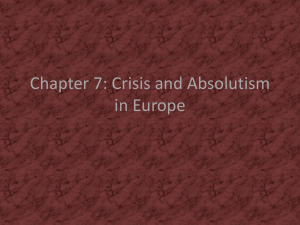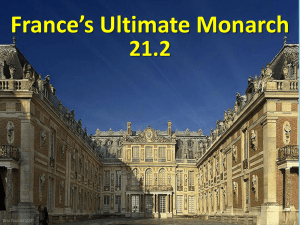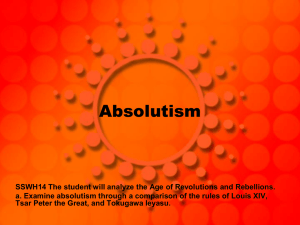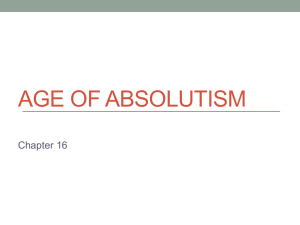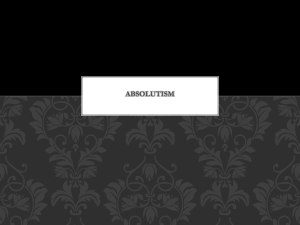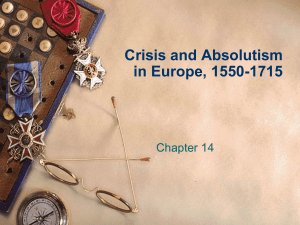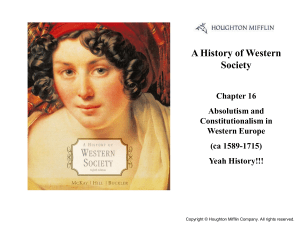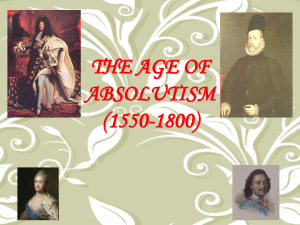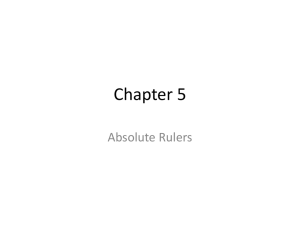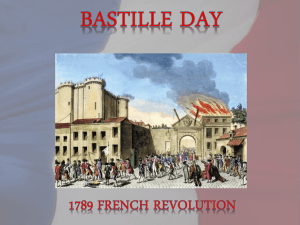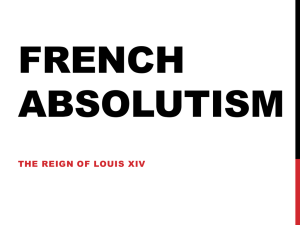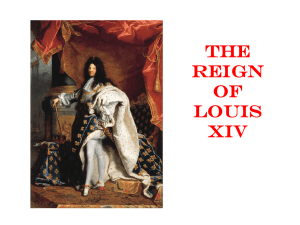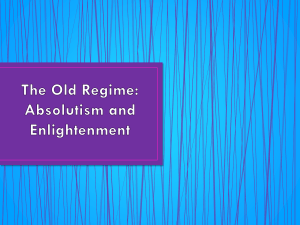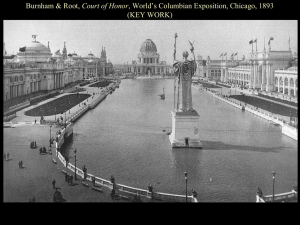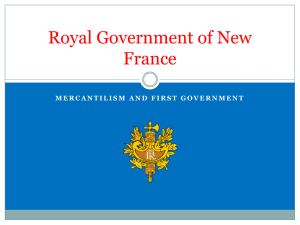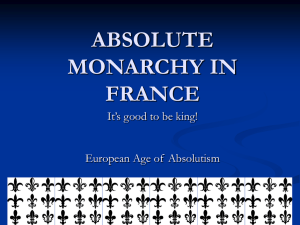Crisis and Absolutism
advertisement
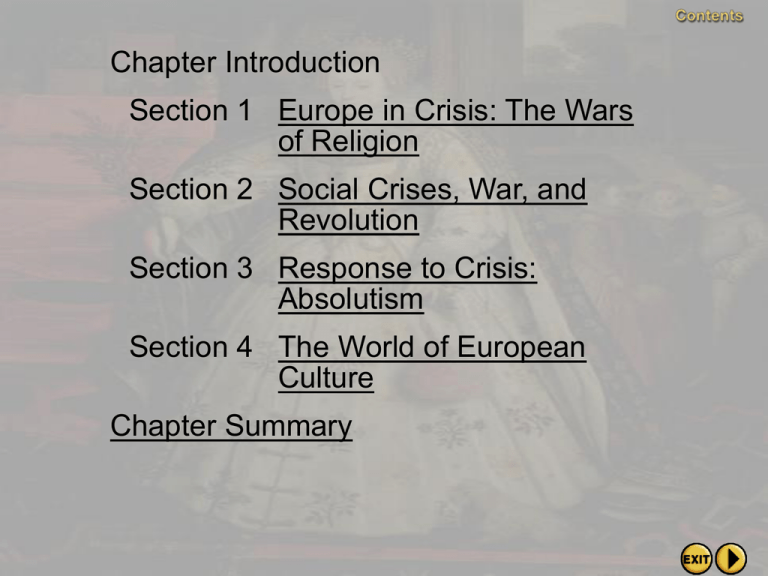
Chapter Introduction Section 1 Europe in Crisis: The Wars of Religion Section 2 Social Crises, War, and Revolution Section 3 Response to Crisis: Absolutism Section 4 The World of European Culture Chapter Summary During the reign of her half sister Mary, Elizabeth I was arrested and sent to the Tower of London on suspicion of contributing to a plot to overthrow the government and restore Protestantism. Two months of interrogation and spying revealed no conclusive evidence of treason. Therefore, Elizabeth was released from the tower and placed in close custody for a year. Europe in Crisis: The Wars of Religion Preview of Events The French Wars of Religion • Calvinism and Catholicism had become militant (combative) religions by 1560. • Their struggle for converts and against each other was the main cause of Europe’s sixteenthcentury religious wars. (pages 211–212) The French Wars of Religion (cont.) • The French civil wars known as the French Wars of Religion (1562–1598) were shattering. • The Huguenots were French Protestants influenced by John Calvin. • Only 7 percent of the population, Huguenots made up almost 50 percent of the nobility, including the house of Bourbon, which ruled Navarre and was next in line for the Valois dynasty. The French Wars of Religion (cont.) • The Valois monarchy was strongly Catholic. • A group in France called the ultraCatholics also strongly opposed the Huguenots. The French Wars of Religion (cont.) • Many townspeople were willing to help nobles weaken the monarchy, so they became a base of opposition against the Catholic king. • Civil war raged for 30 years until in 1589, Henry of Navarre, leader of the Huguenots, succeeded to the throne as Henry IV. The French Wars of Religion (cont.) • He converted to Catholicism because he realized that a Protestant would not have the support of French Catholics. • He issued the Edict of Nantes in 1598. • It recognized Catholicism as France’s official religion, but gave the Huguenots the right to worship and to have all political privileges, such as holding office. (pages 211–212) Phillip II and Militant Catholicism • King Philip II of Spain was the greatest supporter of militant Catholicism. • He ruled from 1556 to 1598, and his reign began a period of cultural and political greatness in Spain. Phillip II and Militant Catholicism • Philip II wanted to consolidate control over his lands–Spain, the Netherlands, and possessions in Italy and the Americas. • He strengthened his control of his domain by insisting on strict adherence to Catholicism and support for the monarchy. • Spain saw itself as the nation God chose to save Catholic Christianity from the Protestant heretics. (pages 212–213) Phillip II and Militant Catholicism • Philip II became a champion of Catholicism. • Under Spain’s leadership he formed a Holy League against the Turks. • He roundly defeated their fleet in the famous Battle of Lepanto in 1571. Phillip II and Militant Catholicism • The Spanish Netherlands–modern Netherlands and Belgium–was very rich. • Nobles there resented Philip II trying to consolidate his control of their lands. • He also tried to crush Calvinism there. • When Calvinists began to destroy church statues, Philip sent ten thousand troops to stop the rebellion. Phillip II and Militant Catholicism • In the north, the Dutch prince William the Silent offered growing resistance to Philip. • In 1609, a 12-year truce stopped the wars. • The north became the United Provinces of the Netherlands, which was one of Europe’s great powers and the core of the modern Dutch state. Phillip II and Militant Catholicism • Spain was the world’s most populous empire when Philip’s reign ended in 1598. • It seemed a great power, but in reality Philip had bankrupted the country by spending too much on war. • His successor continued to overspend, now on court life. • Further, Spain’s armed forces were out-ofdate and the government was inefficient. • Real power shifted to England. The England of Elizabeth • Elizabeth Tudor ascended to the throne of England in 1558. • During her reign, this small island became the leader of the Protestant nations and laid the foundation for becoming a world empire. The England of Elizabeth (cont.) • Elizabeth quickly tried to resolve the religious conflicts. • She repealed laws favoring Catholics. • A new Act of Supremacy named her as “the only supreme governor” of church and state. • The Church of England practiced a moderate Protestantism. (pages 213–214) The England of Elizabeth (cont.) • Elizabeth was moderate in foreign affairs as well. • She tried to keep France and Spain from becoming too powerful by supporting first one and then the other, balancing their power. • Even so, she could not escape a conflict with Spain. • Philip II had long toyed with the idea of invading England to return it to Catholicism. The England of Elizabeth (cont.) • In 1588, Spain sent an armada–a fleet of warships–to invade England. • Yet the fleet that sailed had neither the manpower nor the ships to be victorious. • The Spanish fleet was battered in numerous encounters and finally sailed home by a northward route around Scotland and Ireland, where storms sank many ships. Checking for Understanding Define Match each definition in the left column with the appropriate term in the right column. __ 1. a fleet of warships A. militant __ 2. combative B. armada Social Crises, War, and Revolution Preview of Events After the restoration of King Charles II, Oliver Cromwell’s embalmed remains were dug out of his Westminster Abbey tomb and hung up at Tyburn, where criminals were executed. His body was then buried beneath the gallows. Cromwell’s head, however, was stuck on a pole on top of Westminster Hall for the duration of Charles II’s reign. Economic and Social Crises • From 1560 to 1650, Europe experienced economic and social crises. • One economic problem was inflation– rising prices–due to the influx of gold from the Americas and increased demand for land and food as the population grew. (pages 216–217) Economic and Social Crises (cont.) • By 1600, an economic slowdown had hit Europe. • For example, Spain’s economy seriously fell by the 1640s because mines in the Americas were producing less silver, pirates grabbed much of what was bound for Spain, and the number of Muslim and Jewish merchants and artisans had declined. (pages 216–217) Economic and Social Crises (cont.) • By 1620, population began to decline, especially in central and southern Europe. • Warfare, plague, and famine all contributed to the population decline and general social tension. Economic and Social Crises (cont.) Why might an influx of currency raise prices? The more money people have to spend, the more competition there is among buyers for products, so sellers are able to raise prices and still sell successfully. (pages 216–217) The Witchcraft Trials • A belief in witchcraft, or magic, had been part of traditional village life for centuries. • The zeal behind the Inquisition was soon focused on witchcraft, and many people in Europe were seized by a hysteria about the matter. (page 217) The Witchcraft Trials (cont.) • Perhaps more than one hundred thousand people were charged with witchcraft. • Most often common people were accused. • More than 75 percent of the accused were women, mostly single, widowed, or over 50. • Accused witches were tortured and usually confessed to such things as swearing allegiance to the devil, casting spells, and attending revels at night called sabbats. The Witchcraft Trials (cont.) • Malleus Maleficarum 1487 (The Witches Hammer): Heinrich Kramer/ Jacob Sprenger • As governments strengthened after the period of crises, they were not tolerant of having witch trials disrupt society. • Also, attitudes were changing: many people found it unreasonable to believe in a world haunted by evil spirits. The Thirty Years’ War • Religious disputes continued in Germany after the Peace of Augsburg in 1555 principally because the peace settlement did not recognize Calvinism, which spread throughout Europe. The Thirty Years’ War (cont.) • Religion, politics, and territory all played a role in the Thirty Years’ War, called the “last of the religious wars.” • The war began in the Holy Roman Empire in 1618 as a fight between the Hapsburg Holy Roman emperors and Protestant nobles in Bohemia who rebelled against the Hapsburgs. • All major European countries but England became involved. (pages 217–218) The Thirty Years’ War (cont.) • Most important was the struggle between France, on the one hand, and Spain and the Holy Roman Empire, on the other hand, for European leadership. The Thirty Years’ War (cont.) • The battles took place on German soil, and Germany was plundered and destroyed for 30 years. • The Peace of Westphalia ended the war in 1648. • Some countries gained new territories, and France emerged as the dominant nation in Europe. The Thirty Years’ War (cont.) • The Peace of Westphalia said all German states could determine their own religion. • The states that made up the Holy Roman Empire became independent. • The Holy Roman Empire died, and Germany would not reunite for two hundred years. (pages 217–218) The Thirty Years’ War (cont.) • The Thirty Years’ War was Europe’s most destructive ever. • The flintlock musket, soon fitted with a bayonet, was a new, accurate weapon that could be reloaded faster than earlier firearms. • Increased use of firearms and greater mobility on the battlefield meant armies had to be better disciplined and trained. • Governments began to support standing armies. • By 1700, France had a standing army of four hundred thousand. Revolutions in England • The seventeenth century saw England’s civil war, the English Revolution. • In essence, it was a struggle between Parliament and the king to determine the power of each in governing England. (pages 219–221) Revolutions in England (cont.) • The Tudor dynasty ended with Elizabeth’s death in 1603. • The Stuart king of Scotland, James I, ascended to the throne. • He believed in the divine right of kings– that kings receive their power from God and are responsible only to God. • Parliament wanted an equal role in ruling, however. (pages 219–221) Revolutions in England (cont.) • Religion was an issue as well. • Puritans (one group of English Calvinists) disagreed with the king’s defense of the Church of England, wanting it to be more Protestant. • Many Puritans served in the House of Commons, the lower house of Parliament, which gave them power. Revolutions in England (cont.) • Conflict came to a head under the reign of James I’s son, Charles I, who also believed in the divine right • of kings. • In 1628, Parliament passed a petition prohibiting passing taxes without Parliament’s consent. • Charles I also tried to add ritual to the Protestant service, which to the Puritans seemed a return to Catholicism. Revolutions in England (cont.) • Civil war broke out in 1642 between supporters of the king (Cavaliers or Royalists) and those of Parliament (Roundheads). • Parliament won, principally because of the New Model Army of its leader and military genius, Oliver Cromwell. • His army was made up chiefly of extreme Puritans known as the Independents. • They believed they were doing battle for God. (pages 219–221) Revolutions in England (cont.) • Cromwell purged Parliament of anyone who had not supported him, and the remainder of Parliament executed Charles I in 1649. • The execution of the king horrified much of Europe. • Parliament abolished the monarchy and the House of Lords, and declared a republic, or commonwealth. (pages 219–221) Revolutions in England (cont.) • Cromwell soon dismissed Parliament and set up a military dictatorship. • He ruled until his death in 1658. • Parliament then restored the monarchy, and Charles II took the throne. • Under the restored Stuart monarchy, Parliament kept much of the power it had gained. • It restored the Church of England as the state religion and restricted some rights of Catholics and Puritans. Revolutions in England (cont.) • In 1685, James II became king. • He was a devout Catholic. • James named Catholics to high positions in the government, armed forces, and universities. • Conflict over religion again brewed. Revolutions in England (cont.) • Parliament did not want James II’s Catholic son to assume the throne. • A group of English noblemen invited the Dutch leader, William of Orange, husband of James’s daughter Mary, to invade England. • William and Mary raised an army and marched to England. • James and his family fled, so with almost no violence, England underwent its “Glorious Revolution.” • The issue was who would be monarch. (pages 219–221) Revolutions in England (cont.) • William and Mary accepted the throne in 1689 along with a Bill of Rights, which set forth Parliament’s right to make laws and levy taxes. • In addition, standing armies could be raised only with Parliament’s consent. • The rights of citizens to bear arms and to a jury trial were also part of the document. • The Bill of Rights helped create a government based on the rule of law and a freely elected Parliament. (pages 219–221) Revolutions in England (cont.) • The Toleration Act of 1689 gave Puritans, not Catholics, the right of free public worship. • Few English citizens were persecuted for religion ever again. • By deposing one king and establishing another, Parliament had destroyed the divine right theory of kingship. (pages 219–221) Checking for Understanding Define Match each definition in the left column with the appropriate term in the right column. __ D 1. a republic A. inflation __ A 2. a rapid increase in prices B. witchcraft __ B 3. the practice of magic by people supposedly in league with the devil C. divine right of kings __ C 4. the belief that kings receive their power from God and are responsible only to God D. commonwealth Response to Crisis: Absolutism Preview of Events At the time of his father’s death, the fouryear-old Louis XIV was, according to the laws of his kingdom, the owner of the bodies and property of 19 million subjects. Nonetheless, he once narrowly escaped drowning in a pond because no one was watching him. France under Louis XIV • One response to the crises of the seventeenth century was to seek stability by increasing the monarchy’s power. • This response historians call absolutism, a system in which the ruler has total power. • It also includes the idea of the divine right of kings. • Absolute monarchs could make laws, levy taxes, administer justice, control the state’s officials, and determine foreign policy. (pages 223–226) France under Louis XIV (cont.) • The best example of seventeenth-century absolutism is the reign of Louis XIV of France. • French power and culture spread throughout Europe. • Other courts imitated the court of Louis XIV. (pages 223–226) France under Louis XIV (cont.) • Louis XIII and Louis XIV were only boys when they came to power. • A royal minister held power for each up to a certain age, Cardinal Richelieu for Louis XIII and Cardinal Mazarin for Louis XIV. (pages 223–226) France under Louis XIV (cont.) • Richelieu took political and military rights from the Huguenots, a perceived threat to the throne, and thwarted a number of plots by nobles through a system of spies, executing the conspirators. (pages 223–226) France under Louis XIV (cont.) • Louis XIV came to the throne in 1643 at age four. • During Mazarin’s rule, nobles rebelled against the throne, but their efforts were crushed. • Many French people concluded that the best chance for stability was with a monarch. (pages 223–226) France under Louis XIV (cont.) • The royal court Louis established at Versailles served three purposes. • It was the king’s household, the location of the chief offices of the state, and a place where the powerful could find favors and offices for themselves. • From Versailles, Louis controlled the central policy-making machinery of government. (pages 223–226) France under Louis XIV (cont.) • Louis deposed nobles and princes from the royal council and invited them to Versailles where he hoped court life would distract them from politics. • This tactic often worked. • Louis’s government ministers were to obey his every wish. • He ruled with absolute authority in the three traditional areas of royal authority: foreign policy, the Church, and taxes. France under Louis XIV (cont.) • Louis had an anti-Huguenot policy, wanting the Huguenots to convert to Catholicism. • As many as two hundred thousand Protestants fled France. • The mercantilist policies of the brilliant Jean-Baptiste Colbert helped Louis with the money he needed for maintaining his court and pursuing his wars. France under Louis XIV (cont.) • Louis developed a standing army of four hundred thousand. • He wanted the Bourbon dynasty to dominate Europe. • To achieve this goal, he waged four wars between 1667 and 1713, causing many other nations to form alliances against him. • He did add some lands to France and set up a member of his dynasty on Spain’s throne. France under Louis XIV (cont.) • The Sun King died in 1715. • France was debtridden and surrounded by enemies. • On his deathbed he seemed remorseful for not caring for the people more. Absolutism in Central and Eastern Europe • After the Thirty Years’ War, two German states–Prussia and Austria–emerged in the seventeenth and eighteenth centuries as great powers. • Frederick William the Great Elector laid the basis for the Prussian state. • He built an efficient standing army of forty thousand men, the fourth-largest army in Europe. (pages 226–227) Absolutism in Central and Eastern Europe (cont.) • The Austrian Hapsburgs had long been Holy Roman emperors. • After the Thirty Years’ War, they created a new empire in eastern and southeastern Europe. • Its core was in present-day Austria, the Czech Republic, and Hungary. • After the defeat of the Turks in 1687, Austria took control of Transylvania, Croatia, and Slavonia as well. Russia under Peter the Great • In the sixteenth century, Ivan IV became the first Russian ruler to take the title of czar, Russian for caesar. • Called Ivan the Terrible for his ruthlessness, he expanded Russia eastward and crushed the power of the Russian boyars (the nobility). Russia under Peter the Great (cont.) • The end of Ivan’s rule in 1598 was followed by a period of anarchy called the Time of Troubles. • It ended when the national assembly chose Michael Romanov as czar in 1613. • The Romanov dynasty lasted until 1917. Russia under Peter the Great (cont.) • Its most prominent member was Peter the Great, an absolutist who believed in the divine right of kings. • He became czar in 1689. • Peter soon made a trip to the West, and he returned determined to Europeanize Russia. • He wanted European technology to create a great army to support Russia as a great power. • By Peter’s death in 1725, Russia was an important European state. Russia under Peter the Great (cont.) • To create his army, Peter drafted peasants for 25-year stints. • He also formed the first Russian navy. • He divided Russia into provinces to rule more effectively. • He wanted to create a “police state,” by which he meant a wellordered community governed by law. Russia under Peter the Great (cont.) • Peter introduced Western customs and etiquette. • At court, Russian beards had to be shaved and coats shortened, for example, as were the customs in Europe. • Upper-class women gained much from Peter’s reforms. • He insisted they remove their veils, and he held gatherings for conversation and dancing where the sexes mixed, as in Europe. Russia under Peter the Great (cont.) • Peter’s goal was to make Russia a great power. • An important part of this was finding a port with access to Europe through the Baltic Sea. • At the time, Sweden controlled the Baltic. • Peter warred with Sweden, and he acquired the lands he needed. • On the Baltic in 1703, he began construction of a new city, St. Petersburg. • It was the Russian capital until 1918. Checking for Understanding Define Match each definition in the left column with the appropriate term in the right column. __ A 1. a political system in which a ruler holds total power A. absolutism __ C 2. a Russian noble C. boyar __ B 3. Russian for “caesar,” the title used by Russian emperors B. czar Enlightenment and Enlightened Absolutism (cont.) • After several weak rulers following Peter the Great’s death, Catherine the Great, the German wife of the murdered Peter III, came to the Russian throne. • She ruled from 1762 to 1796. • She invited philosophers to speak to her “man to man.” Enlightenment and Enlightened Absolutism (cont.) • Conditions for the peasants worsened, and Catherine the Great responded strongly to a peasant revolt. • Serfdom was expanded to newer parts of the empire. • She effectively expanded Russia’s territory. • For example, in the west, Russia gained about 50 percent of Poland’s territory. (pages 310–313) Mannerism • The artistic Renaissance ended when the movement called Mannerism emerged in Italy in the 1520s and 1530s. • Mannerism broke down the High Renaissance values of balance, harmony, moderation, and proportion. The Baroque Period • The baroque movement replaced Mannerism. • It began in Italy at the end of the sixteenth century and was adopted by the Catholic reform movement. • Hapsburg court buildings in Madrid, Prague, Vienna, and Brussels show this style. A Golden Age of Literature • In both England and Spain, writing for the theater reached new heights between 1580 and 1640. • Most notable was the drama of the time, especially that of William Shakespeare. • Shakespeare’s works were performed principally at the Globe Theater. • The low admission charge allowed the lower classes to attend, and Shakespeare had to write plays pleasing to all classes and types. Political Thought • The seventeenth century was concerned with order and power. • These concerns are reflected in the political philosophies of two different Englishmen. Political Thought (cont.) • England’s revolutionary upheavals alarmed Thomas Hobbes. • He wrote a work on political thought, Leviathan (1651), to deal with the issue of disorder. • He claimed that before society and politics, in what he called a “state of nature,” life is brutal and violent because human nature is selfinterested. • Life is not about morals, but selfpreservation. Political Thought (cont.) • John Locke wrote a political work called Two Treatises of Government (1690). • People had natural rights– rights with which people are born. ). • He argued that people are born with a mind that is a tabula rasa, or blank slate, and that knowledge comes to it through the five senses. • People should be reasonable towards government, and government should protect the people’s rights. • If the contract is broken, people have a right to overthrow the government. Descartes and Reason • The work of the French philosopher René Descartes strongly reflects the Western view of humankind that came from the Scientific Revolution. • In his Discourse on Method (1637), he asserts that he can rationally be sure of only one thing–his own existence. • He asserted he would accept only those things his reason said were true. Descartes and Reason (cont.) • Descartes asserted that while he could not doubt the existence of his mind–“I think, therefore I am”–he could doubt the existence of the material world. • Mrs. Gupton’s favorite quote: “I may have been mistaken and everything I thought was diamonds and gold may perhaps be nothing but copper and glass.” "Cogito, ergo sum" Descartes and Reason (cont.) • Descartes has been called the father of modern rationalism. • This system of thought is based on the idea that reason is the chief source of knowledge. Philosophes and Their Ideas (cont.) • Charles-Louis de Secondat, the Baron de Montesquieu, studied governments to find the natural laws governing social and political relationships. • His analysis of the English monarchy is his most lasting contribution. • He argued that the government functioned through a separation of powers controlled by checks and balances. • Montesquieu’s ideas influenced the American framers of the Constitution. Philosophes and Their Ideas (cont.) • The greatest figure of the Enlightenment was the prolific writer François-Marie Arouet, known simply as Voltaire. • He championed deism, an eighteenthcentury religious philosophy based on reason and natural law. • Deists believe the world is like a clock that God created and set according to his natural laws, and then let run without his intervention. Toward a New Social Science (cont.) • The French Physiocrats and Scottish philosopher Adam Smith founded modern economics. • They developed the doctrine of laissezfaire (“to let [people] do [what they want]”), which argued that the government should not interfere with natural economic processes by imposing regulations. The Later Enlightenment • Jean-Jacques Rousseau was the most famous. In his Discourse on the Origins of the Inequality of Mankind, he argued that people formed governments and laws to protect their private property, but the government relationship enslaved them. • In The Social Contract (1762), he presented the idea of a social contract in which members of society agree to be governed by the general will, which represents what is best for society as a whole. Chapter Summary The rulers of Europe during the sixteenth, seventeenth, and early eighteenth centuries battled to expand their borders, power, and religion. This chart summarizes some of the events of the chapter.
